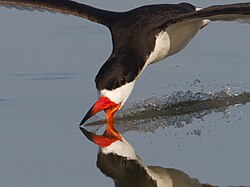| Black skimmer | |
|---|---|
 | |
| Black skimmer in breeding plumage. | |
 | |
| Black Skimmer chick | |
| Scientific classification | |
| Kingdom: | Animalia |
| Phylum: | Chordata |
| Class: | Aves |
| Order: | Charadriiformes |
| Family: | Laridae |
| Genus: | Rynchops |
| Species: | R. niger |
| Binomial name | |
| Rynchops niger | |
 | |
| Synonyms | |
Rynchops fulvaLinnaeus, 1758 | |
The black skimmer (Rynchops niger) is a tern-like seabird, one of three similar bird species in the skimmer genus Rynchops in the gull family Laridae. It breeds in North and South America. Northern populations winter in the warmer waters of the Caribbean and the tropical and subtropical Pacific and Atlantic coasts, but South American populations make only shorter movements in response to annual floods which extend their feeding areas in the river shallows.










